Heroes of Space: Alexei Leonov – Space.com
Today spacewalks are an almost routine part of space exploration but the very first spacewalk by Alexei Leonov, who died last week at 85, was anything but straightforward.
Born in the Altai region of Siberia on May, 30 1934, he graduated from a selection of air force academies with honours and was quickly picked to be one of the first 20 cosmonauts for the Soviet space program.
Leonov had actually expected to become a professional artist, but his life took a very different turn, as he became a key player in the Space Race. In 1965 the Soviet Union was well ahead of the U.S. in the race to land humans on the moon: they had already launched the first satellite, animal, man and woman into space.
Related: Alexei Leonov: Spacewalk Pioneer
More: The Top 10 Russian and Soviet Space Missions
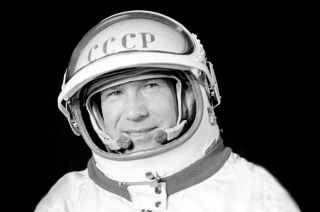
Alexei Leonov, who performed the world’s first spacewalk in 1965 and co-led the first joint mission between the U.S. and Russia, died on Friday, Oct. 11, 2019 in Moscow at age 85.
(Image credit: Roscosmos)
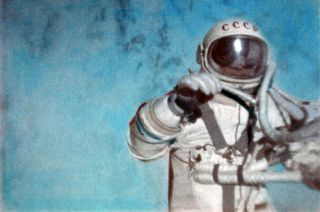
Archived image from the Fédération Aéronautique Internationale report certifying the first spacewalk by Russian cosmonaut Alexei Leonov on March 18, 1965.
(Image credit: FAI)
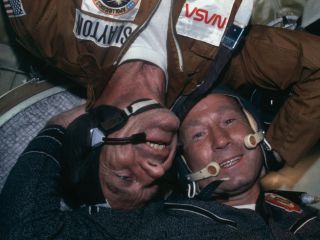
In 1975, Alexei Leonov (right) participated in the Apollo-Soyuz Test Project, which became the first crewed international spaceflight. This image from the flight shows Leonov with NASA astronaut Deke Slayton.
(Image credit: NASA)
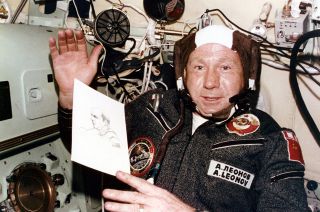
Cosmonaut Alexei Leonov aboard the Apollo-Soyuz Test Project with a sketch he made of one of his American crewmates.
(Image credit: NASA)
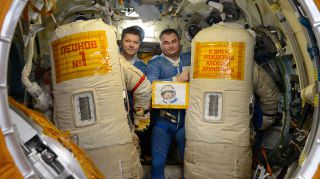
Russian cosmonauts Oleg Kononenko and Alexey Ovchinin honor Alexei Leonov when conducting a spacewalk the day before his 85th birthday.
(Image credit: NASA/Roscosmos)

An in-depth look at the world’s first spacewalk by cosmonaut Alexei Leonov on March 18, 1965.
(Image credit: By Karl Tate, Infographics Artist)
Launched on Voskhod 2, the world’s 17th human spaceflight, on March 18, 1965, Leonov made history as the first person to exit his spacecraft for an extravehicular activity (EVA).
“The Earth is round!” he exclaimed, as he caught his first view of the world. “Stars were to my left, right, above and below me. The light of the sun was very intense and I felt its warmth on the part of my face that was not protected by a filter,” said Leonov in a 2015 interview with the Fédération Aéronautique Internationale (FAI) on the 50th anniversary of his spacewalk.
“What remain etched in my memory was the extraordinary silence,” he said.
When the Soviet Union learned that the U.S. was planning the first spacewalk their efforts became focused on beating them to it. Leonov underwent 18 months of intensive weightlessness training and, while the U.S. spacewalk was scheduled for June, Leonov was first blasted into orbit on March 18, 1965.
Leonov shared the two-man Voskhod capsule with Pavel Belyayev and once it had completed one orbit, was given the all clear to begin his historic walk. He crawled into the airlock, opened the hatch, slid out and floated into space. The defining memory for Leonov, as he would later recount, was the all-encompassing silence of space.
“It was so quiet I could even hear my heart beat. I was surrounded by stars and was floating without much control. I will never forget the moment. I also felt an incredible sense of responsibility.”
Video: Watch Alexei Leonov’s Harrowing Spacewalk
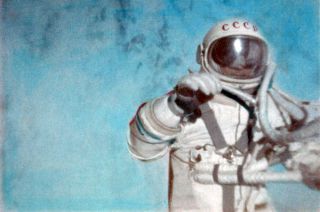
Archived image from the Fédération Aéronautique Internationale (FAI) report certifying that the first spacewalk was conducted by cosmonaut Alexei Leonov on March 18, 1965.
(Image credit: Roscosmos/FAI)
For a duration of 12 minutes and nine seconds, the cosmonaut conducted the first ever spacewalk, while connected to the spacecraft by a 5.4-metre (17.6-foot) tether. However, Leonov’s true test of skill came when he attempted to return to the ship.
Experts had not foreseen the effect the vacuum of space would have on the cosmonaut’s suit — it was steadily inflating. As the difference in air pressure caused the suit to balloon out of shape, Leonov’s hands were pushed out of the gloves and his feet out of his boots. In fact the suit had ballooned so much that he was unable to return through the airlock and to add even more danger, he only had five minutes before the craft would enter Earth’s shadow and be plunged into total darkness.
Acting quickly, Leonov bled some air out of the suit by opening a valve. The suit slowly deflated, but he was already feeling the effects of decompression sickness, with pins and needles in his hands and legs.
Related: How Leonov’s Historic First Spacewalk Worked (Infographic)
In Pictures: The Most Memorable Spacewalks in History
Just in time, Leonov managed to force himself through the airlock headfirst and close the hatch behind him. However, Leonov’s troubles were far from over: as the capsule attempted
to re-enter Earth’s atmosphere it malfunctioned and after an emergency landing, Leonov and Belyayev found themselves hundreds of miles off course in a remote area of the Ural mountains.
For two freezing nights, the men waited in temperatures below zero before they were finally rescued. The Soviet Union were quick to celebrate the mission as a success, but it very nearly ended in disaster.
Leonov was hailed as a hero of the Soviet Union for his spacewalk, but it would be 10 years before he re-entered space. He served as commander on the 1975 Soyuz 19 mission, the first joint Soviet-U.S. space mission, called the Apollo-Soyuz Test Project. His friendly demeanour and efforts to learn English impressed Americans and softened western perceptions of Russian cosmonauts.
Related: Apollo-Soyuz Test Project: 1st U.S.-Russian Spaceflight Pictures
After the mission, Leonov continued to play a major role in space exploration for many years, editing the cosmonaut newsletter ‘Neptune’ and overseeing crew training.
When Leonov entered the Soviet space program, it was focused on beating its American competitors, but when he retired in 1991, it was from a different organisation entirely, with Leonov describing the crew of his joint American and Soviet mission as, “Dear and intelligent people who decided to show all of humanity that we are different…but can work together.”

This story was provided by All About Space, Space.com’s print publication partner.
(Image credit: All About Space Banner)






